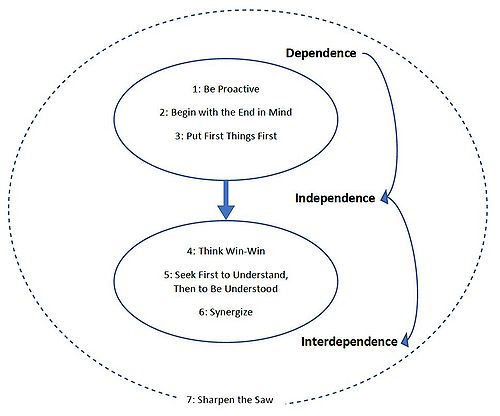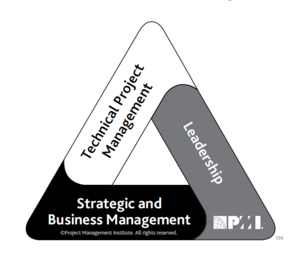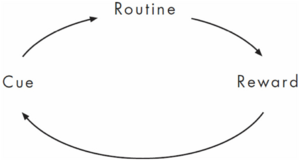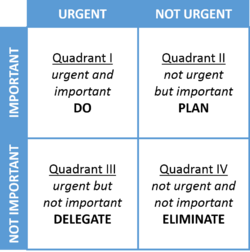The 7 Habits of Highly Effective People for Successful Leadership
Created by Lena Maria Thyen (s202969)
Contents |
Abstract
The skills and competences of a project manager are crucial for a project to succeed. Besides technical project management skills and strategic as well as business management skills, a successful and effective project manager is also characterized by leadership skills and competences. Some of the most important leadership skills, qualities and competences include: being optimistic and positive, being collaborative, being able to managing relationships and conflicts, asking and listening, being a problem solver, being a life-long learner who is results- and action-oriented, being able to focus on the important things, being able to have fun and share humour effectively with team members [1] (pp. 51-62). These skills and competences are discussed in the personality development book The 7 Habits of Highly Effective People, which the American author Stephen Covey wrote in 1990. Covey describes an inside-out approach that focuses on character ethics rather than personality ethics. According to Covey, personal and professional success is going to be achieved by adopting these seven habits: 1) be proactive, 2) begin with the end in mind, 3) put first things first, 4) think win-win, 5) seek first to understand, then to be understood, 6) synergize, 7) sharpen the saw. When implementing these habits into the character, three stages 1) dependence, 2) independence and 3) interdependence are passed in succession, which Covey describes as the maturity continuum. The fact that these skills and competences can be trained as habits and thus be integrated into the character enables employees and thus companies to achieve increased effectiveness in project management through the use of this personality development tool [2]. Therefore, this article focusses on the connection between the seven habits of highly effective people and a successful leadership of project managers. Further, instructions on how this tool can be used in the area of project management are given.
The 7 Habits of Highly Effective People
In this personality development book, success is defined out of two different points of view, the personality ethic and the character ethic. Success from the personality ethic perspective is measured in terms of personality, public image, attitudes and behaviors, skills and techniques, that eases the processes of human interaction whereas from the character ethic perspective success is defined in terms of integrity, humility, fidelity, temperance, courage, justice, patience, industry, simplicity and modesty. According to Covey, principles through character ethic are the basis for this inside-out approach and are key to maintain lasting human relationships and to achieve long-term success [2](pp. 7-9). These character ethic-based skills and competencies can be learned by adopting the following seven habits.

1: Be Proactive:
- Take responsibility for your own actions and focus time and energy on the things inside the Circle of Influence which includes things that you can control and influence in order to achieve more positive results. This can for example be your fitness, your education, your hobbies or your habits.
- In order to become a proactive person, it is essential to develop an awareness of what things we can influence with our actions and to focus on them instead of things within the Circle of Concern which we cannot change.
[2] (pp. 31-44)
2: Begin with the End in Mind:
- Set yourself a personal mission statement which describes a clear vision of your goals in life.
- Put yourself in the position of an author of your own life. This realization combined with a proactive mindset is supposed to ensure that whenever a decision has to be made, the focus on whether these decisions are in line with one's own goals or with the mission statement of the person you want to be.
[2] (pp. 45-73)
3: Put First Things First:
- Prioritize the things that lead you to the goals defined in habit two.
- In habit two you should have understood that you are the author of your own life. This habit is about writing your own life, i.e. turning your visions into reality and making decisions accordingly while thinking proactively.
[2] (pp. 73-90)
4: Think Win-Win:
- Acquire a win-win mind-set by being in balance between courage and consideration.
- This has the advantage that while we work together we share our knowledge and can grow and benefit from one another.
[2] (pp. 102-119)
5: Seek First to Understand, Then to Be Understood:
- First, listen to understand a person intellectually and emotionally. This type of listening is called empathic listening and is the highest form of listening which creates a feeling of care and empathy.
- Next, give an honest and valuable advice from own point of view if requested.
[2] (pp. 119-133)
6: Synergize:
- Cooperate with people with different backgrounds, perspectives, opinions, ideas and strengths in order to incorporate the value of each individual and thereby achieve better results. Through synergy, things can be discovered that someone is less likely to discover alone.
[2] (pp. 133-146)
7: Sharpen the Saw:
- Take time for self-care and self-renewal in order to stay balanced and thus to be and stay effective. Here, the saw is used as metaphor. It needs to be sharpened to be able to saw properly.
- Focus on the maintenance of the physical (beneficial eating, exercising and resting), social and emotional (making social and meaningful connections to others) and the mental and spiritual (spending time in nature, spiritual self through meditation, music, art, expand prayer or ministry) conditions. This habit is the basis for staying balanced to be able to handle the other six habits.
[2] (pp. 147-158)
Competences and Habits of Highly Effective Project Managers

| Habits
1 to 7 |
Leadership skills / competences |
|---|---|
| 1: Be Proactive |
|
| 2: Begin with the End in Mind |
|
| 3: Put First Things First |
|
| 4: Think Win-Win |
|
| 5: Seek First to Understand, Then to Be Understood |
|
| 6: Synergize |
|
| 7: Sharpen the Saw |
|
How to Achieve Habits
The Habit Loop

Adopt The 7 Habits
1: Be Proactive: [2] (pp. 31-44)
2: Begin with the End in Mind: [2] (pp. 45-73)
3: Put First Things First: [2] (pp. 73-90)
4: Think Win-Win: [2] (pp. 102-119)

5: Seek First to Understand, Then to Be Understood:
[2] (pp. 119-133)
6: Synergize: [2] (pp. 133-146)
7: Sharpen the Saw: [2] (pp. 133-146)
Implementing The 7 Habits in Project Management
[5] (pp. 493-496).
Limitations
Conclusion
Annotated Bibliography
Project Management Institute (Ed.). (2013). A guide to the project management body of knowledge (PMBOK® guide) - 5th Edition. Newtown Square, Penn.: Project Management Institute.
This book provides the fundamentals of project management with focus on performing projects with effective collaboration and the most valuable knowledge on a wide range of projects. The as best recognized practice for project managers are collected in this book and gives project managers the essential tools to practice project management and deliver organizational results.
Bernacer, J., & Murillo, J. I. (2014). The Aristotelian conception of habit and its contribution to human neuroscience. Frontiers in Human Neuroscience, 8. doi:10.3389/fnhum.2014.00883.
This journal gives an in-depth knowledge and understanding of how habits and human neuroscience are linked. It provides a good understanding what habits are and how they are composed.
R. L., Kliem (2008). Effective communications for project management. New York: Auerbach Publications. doi:https://doi.org/10.1201/9781420062489.
This book provides guidelines for effective communication in project management. Tools for active and effective listening are presented which could be interesting as these can help to implement habit number 5: Seek First to Understand, Then to Be Understood of the 7 habits of highly effective people.
Barrett, D. (2013). Leadership communication 4th Edition. New York: McGraw-Hill Education.
This book is about high effective and productive communication for leaders. It provides theoretical background and guidelines how to gain appropriate communication skills which are relevant for leaders.
Maylor, H. (2010). Project Management. Harlow: Financial Times Prentice Hall.
This book is about fundamentals of project management. It provides a deep insight into effective leadership, team management and explains the importance of different roles in a high performing group with focus on different types of projects and situations.
Wisdom For Life (Director). (2018, January 07). The 7 Habits of Highly Effective People Summary [Video file]. Retrieved February 20, 2021, from https://www.youtube.com/watch?v=WFc08j9eorQ&t=4s.
and
Wisdom For Life (Director). (2018, January 07). The 7 Habits of Highly Effective People Summary (part 2) [Video file]. Retrieved February 20, 2021, from https://www.youtube.com/watch?v=5LbCRx1UbWY&t=1s.
In these videos (part 1 and part 2) the essential principle behind The 7 habits of highly effective people by Covey is given in an easily understandable way to get an overview of this personality development tool.
References
- ↑ 1.0 1.1 1.2 Project Management Institute, Inc.. (2017). Guide to the Project Management Body of Knowledge (PMBOK® Guide) (6th Edition). Project Management Institute, Inc. (PMI). Retrieved from https://app.knovel.com/hotlink/toc/id:kpGPMBKP02/guide-project-management/guide-project-management
- ↑ 2.00 2.01 2.02 2.03 2.04 2.05 2.06 2.07 2.08 2.09 2.10 2.11 2.12 2.13 2.14 2.15 2.16 2.17 Covey, S. R. (1990). The 7 habits of highly effective people. New York, USA: Fireside.
- ↑ Duhigg, C. (2012). The power of habit: Why we do what we do in life and business. New York: Random House.
- ↑ First things first (book). (2020, November 17). Retrieved February 27, 2021, from https://en.wikipedia.org/wiki/First_Things_First_(book)
- ↑ Carlone, D. (2001). Management Communication Quarterly. Enablement, Constraint, and the 7 Habits of Highly Effective People, 14(3), 491-497. doi:10.1177/0893318901143007.
Cite error: <ref> tag with name "Aristol" defined in <references> is not used in prior text.